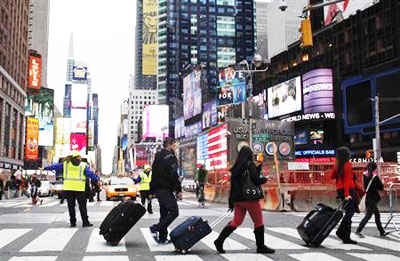
US braces for mammoth storm, NY on high alert
New York, October 29, 2012
Hurricane Sandy, a mammoth storm menacing the East Coast, took aim at the most densely populated US region on Monday, forcing hundreds of thousands to seek higher ground, halting public transport and closing schools, businesses and government departments.
About 50 million people from the Mid-Atlantic to Canada were in the path of the storm, which forecasters say could be the largest ever to hit the US mainland. It is expected to topple trees, damage buildings and cause widespread power outages over the next few days.
Sandy, which killed 66 people in the Caribbean and has brought lashing rains to coastal areas and snow at higher elevations, will cause extensive flooding when it moves inland, forecasters said.
The websites of forecasting services indicated early Monday the storm will strike the New Jersey shore near Atlantic City Monday night.
While Sandy does not pack the punch of Hurricane Katrina, which devastated New Orleans in 2005, its winds stretch some 520 miles from its eye, meteorologists said.
New York and other cities and towns closed their transit systems and schools and ordered mass evacuations from low-lying areas ahead of a storm surge that could reach as high as 11 feet.
All US stock markets will be closed on Monday and possibly Tuesday, the operator of the New York Stock Exchange said late on Sunday, reversing an earlier plan that would have kept electronic trading going on Monday.
More than 7,100 flights canceled so far because of the storm, according to flight tracker FlightAware.com.
Sandy forced President Barack Obama and Republican challenger Mitt Romney to cancel some campaign stops and fueled fears that it could disrupt early voting - encouraged by the candidates this year more than ever - before the November 6 election.
The United Nations, Broadway theaters, New Jersey casinos, schools up and down the Eastern Seaboard, and myriad corporate events are also being shut down.
Officials ordered people in coastal towns and low-lying areas to evacuate, often telling them they would put emergency workers' lives at risk if they stayed.
"Don't be stupid, get out, and go to higher, safer ground," New Jersey Governor Chris Christie told a news conference.
Forecasters said Sandy was a rare, hybrid "super storm" created by an Arctic jet stream wrapping itself around a tropical storm, possibly causing up to 12 inches of rain in some areas, as well as up to 3 feet of snowfall in the Appalachian Mountains from West Virginia to Kentucky.
At 2 am (0600 GMT), the National Hurricane Center said Sandy was centered about 425 miles south southeast of New York City. The storm was turning toward the coast and moving at 14 mph and would bring a "life-threatening" surge, hurricane-force winds and heavy snows in the Appalachian mountains.
Worried residents in the hurricane's path packed stores, searching for generators, flashlights, batteries, food and other supplies in anticipation of power outages. Nearly 284,000 residential properties valued at $88 billion are at risk for damage, risk analysts at CoreLogic said.
Transportation is grinding to a halt, with airlines cancelling flights, bridges and tunnels closing, and Amtrak scrapping nearly all of its passenger rail service on the East Coast. The federal government told non-emergency workers in Washington DC to stay home.
"This is a serious and big storm," Obama said after a briefing at the federal government's storm response center in Washington. "We don't yet know where it's going to hit, where we're going to see the biggest impacts.
Utilities from the Carolinas to Maine reported late Sunday that a combined 14,000 customers were already without power.
The second-largest oil refinery on the East Coast, Phillips 66's 238,000 barrel per day (bpd) Bayway plant in Linden, New Jersey, was shutting down and three other plants cut output as the storm affected operations at two-thirds of the region's plants.
Oil prices slipped on Monday, with Brent near $109 a barrel. "With refineries cutting runs, we're likely to see a build-up in crude stocks which could be driving bearish prices at the moment," said Michael Creed, an economist at National Australia Bank in Melbourne.
New York Mayor Michael Bloomberg ordered the evacuation of some 375,000 people from low-lying areas of the city, from upscale parts of lower Manhattan to waterfront housing projects in the outer boroughs.
While Sandy's 75 mph winds were not overwhelming for a hurricane, its exceptional size means the winds will last as long as two days, bringing down trees and damaging buildings.
"This is not a typical storm," said Pennsylvania Governor Tom Corbett. "It could very well be historic in nature and in scope, and in magnitude because of the widespread anticipated power outages, and the potential major wind damage."
Even with all the warnings, some people tried to carry on with their plans.
"I just don't buy into the hype," said Kate Sullivan, a 40-year-old computer specialist from Alexandria, Virginia, who was headed to Baltimore-Washington International airport for a planned flight to Los Angeles. "I'm pretty sure I'm going to end up in LA by the end of the night."-Reuters







